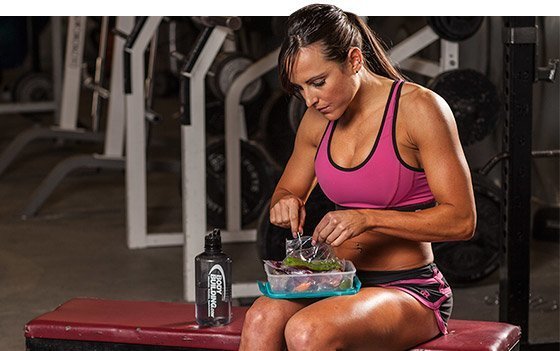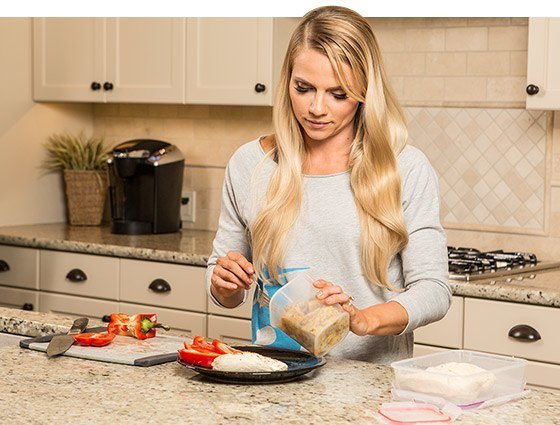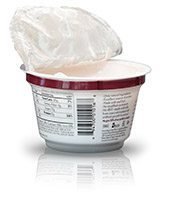When it comes to your diet, forget the fads and start with science. Multiple studies have suggested that higher-protein diets result in greater weight loss, greater fat loss, and higher preservation of lean mass than diets poor in protein.[1] Despite these excellent findings, most people's diets seriously lack in the protein department.
I'm going to help you easily add more protein into your diet with five simple strategies. Before we attack that, however, it's important to establish how much protein you should actually be eating on a daily basis. Let's look at the details.
Protein By Numbers
The Dietary Reference Intakes (DRI) specifies that the dietary protein requirement for all individuals 19 and older is 0.8 grams of protein per each kilogram of bodyweight per day.[1] If you think that sounds low, it is! This amount would be just enough to meet the baseline functions of your body and prevent nutritional deficiency.

A study in the Journal of Sports Science recommends that dietary protein intake for an athlete is 1.3-1.8 g of protein per each kg of bodyweight.
For those of us regularly performing resistance training or taxing endurance activities, our protein intake needs to be a lot higher. The body needs protein to function optimally, adapt to the challenges we are placing on it, and synthesize new muscle in response to these challenges.
A study in the Journal of Sports Science recommends that dietary protein intake for an athlete is 1.3-1.8 g of protein per each kg of bodyweight to allow for optimal adaption.[2]
The same study also found that elevated protein consumption—as high as 1.8-2 g of protein per kg of body weight—may help prevent muscle loss when restricting calories to promote fat loss.[2]
Protein In Perspective
Fulfilling your protein intake requirements takes a little thought and a spot of math. I've taken care of the math for you, but you need to decide which category you fall into.
If you're not accustomed to eating as much protein as suggested, you might feel like there aren't nearly enough meals in the day to ingest hundreds of g of protein. I promise you it is possible, and actually pretty easy, as long as you plan your meals ahead of time.
By incorporating protein into each meal and snack you eat every day, the total will add up quickly. For example, if you weigh 150 pounds and you're trying to preserve muscle while restricting calories, you should eat about 140 g of protein daily. By breaking up those calories into something like six meals per day, you can get to your total by eating about 23 g of protein each time you eat.
If you're not sure how to get 23 g of protein into each meal, here are five easy ways to help. Implement these into your daily habits and you'll be surprised how quickly you can increase your protein intake without making any inconvenient changes to your lifestyle!
1. Be Prepared and Plan Ahead
A little preparation will get you a long way. Being busy isn't an excuse to eat poorly. If you make meals in bulk and pack them up, you can consistently have a week's worth of healthy food at your fingertips.

A little preparation will get you a long way. Being busy isn't an excuse to eat poorly.
Even if you don't want to go full-blown meathead and eat only out of Tupperware, preparing some snacks and lunches to get you through the workday makes a world of difference.
2. Swap out your snacks
Most grab-and-go snacks don't need to be refrigerated. For this reason, carb-heavy snacks like pretzels, cookies, crackers, and granola bars have become the status quo for road trips. If you want to add more protein to your diet, you'll have to ditch these snacks, pick up a cooler, and pack real food.
If carrying a cooler isn't an option, then invest in some jerky, nuts, or high-quality protein bars. Even if you're not going on a long trip, packing nonperishable protein in your purse or briefcase is a perfect way to easily squeeze in another high-protein meal.
Trading carb snacks for protein snacks has the added benefit of subtracting added sugars from your diet. An influx of sugar into the body promotes the release of the fat-storage hormone insulin, which is the last thing you want flooding your body. What you do want hitting your system is fiber, which slows down the insulin response to carbohydrates while offering myriad health benefits.
3. Go Greek

{{caption}}
Greek yogurt has a thick and creamy consistency, and it's action-packed with protein. One cup of 0% Fage plain Greek yogurt has 23 g of protein! If you have a cup of Greek yogurt instead of your usual daily dairy snack, you'll easily bump up your daily protein intake.
Plain Greek yogurt has a slightly sour taste, very similar to sour cream. It can be used in place of cream, milk, cream cheese, sour cream, and mayo in most recipes.
Try a dollop in place of sour cream to top your favorite foods, or simply stir in some Stevia and your favorite fruit for a healthy midday snack.
4. Harness the power of protein powder
You can do a lot more with protein powder than shake it up with some water or milk. I prefer to use my protein powder for baking!
Whether you mix a scoop into your morning oatmeal or use it to make a chocolate crumb crust, having some protein powder readily accessible is an easy way to get more protein into your diet. Adding protein powder to your recipes is also a great way to add flavor and cut some carbs.
The Bodybuilding.com healthy recipe database is full of fun ways to use protein powder. Check it out and try a recipe today!
5. Mix up your meat
It's true that chicken breast and steamed broccoli have all but cornered the fit-meal market. But remember, this combo isn't the only meal a fitness phenom can eat. Keep your taste buds satisfied by enjoying a variety of meats and flavors.
Fish, shrimp, and lobster are great sources of lean protein, and turkey breast and pork loin are great alternatives to chicken breast. You can also eat beef and lamb if you enjoy more flavor.

Fish, shrimp, and lobster are great sources of protein.
Adding some variety to your meat selection is an easy way to increase your protein intake. On those days when you just can't eat another bite of chicken, opt for a different meat source instead of skipping the meal altogether.
References
- Phillips, S. (2006). Dietary Protein For Athletes: From Requirements To Metabolic Advantage. Applied Physiology, Nutrition, and Metabolism, 31(6), 647-654.
- Phillips, S., & Loon, L. (2011). Dietary protein for athletes: From requirements to optimum adaptation. Journal of Sports Sciences, 29, S29-S38.

